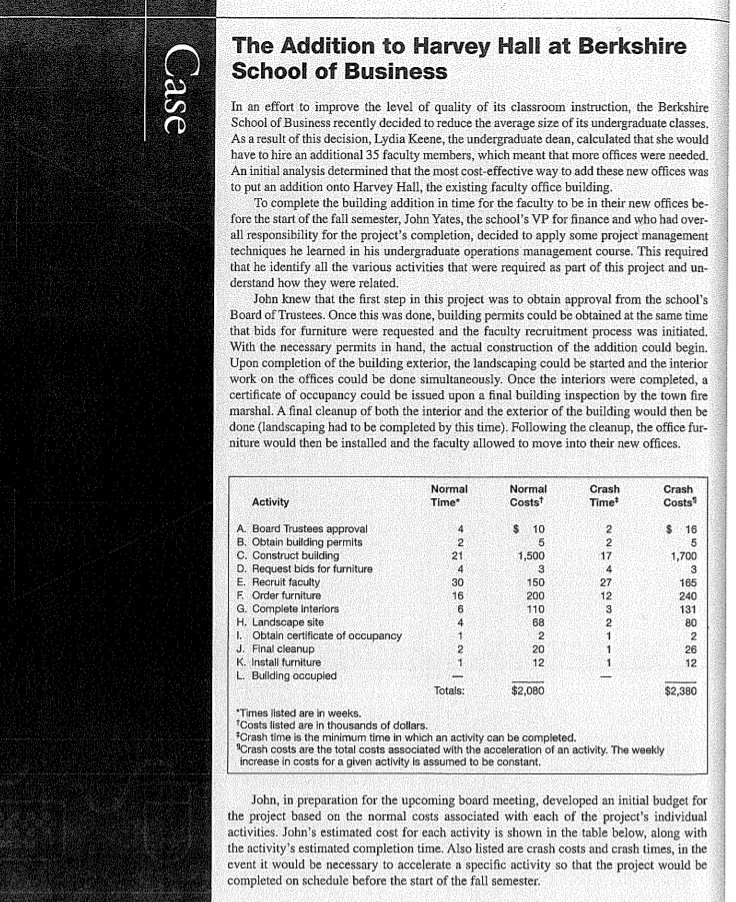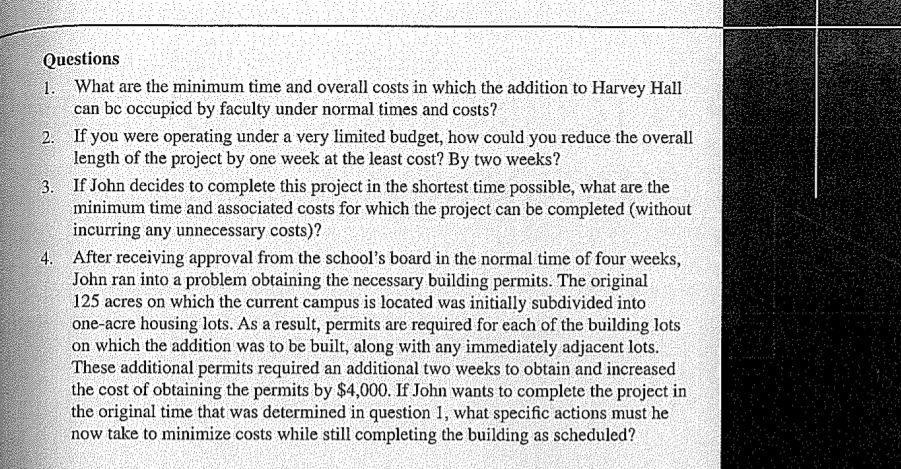Case study
The Addition to Harvey Hall at Berkshire School of Business


The Addition to Harvey Hall at Berkshire School of Business Case In an effort to improve the level of quality of its classroom instruction, the Berkshire School of Business recently decided to reduce the average size of its undergraduate classes. As a result of this decision, Lydia Keene, the undergraduate dean, calculated that she would have to hire an additional 35 faculty members, which meant that more offices were needed. An initial analysis determined that the most cost-effective way to add these new offices was to put an addition onto Harvey Hall, the existing faculty office building. To complete the building addition in time for the faculty to be in their new offices be- fore the start of the fall semester, John Yates, the school's VP for finance and who had over- all responsibility for the project's completion, decided to apply some project management techniques he learned in his undergraduate operations management course. This required that he identify all the various activities that were required as part of this project and un- derstand how they were related. John knew that the first step in this project was to obtain approval from the school's Board of Trustees. Once this was done, building permits could be obtained at the same time that bids for furniture were requested and the faculty recruitment process was initiated. With the necessary permits in hand, the actual construction of the addition could begin. Upon completion of the building exterior, the landscaping could be started and the interior work on the offices could be done simultaneously. Once the interiors were completed, a certificate of occupancy could be issued upon a final building inspection by the town fire marshal. A final cleanup of both the interior and the exterior of the building would then be done (landscaping had to be completed by this time). Following the cleanup, the office fur- niture would then be installed and the faculty allowed to move into their new offices. Normal Time* Normal Costst Crash Time Crash Costs Activity A. Board Trustees approval B. Obtain building permits C. Construct building D. Request bids for furniture E. Recruit faculty F. Order furniture G. Complete Interiors H. Landscape site I. Obtain certificate of occupancy J. Final cleanup K. Install furniture L. Building occupled 4 2 21 4 30 16 6 4 $ 10 5 1,500 3 150 200 110 68 2 20 12 2 2 17 4 27 12 3 2 $ 16 5 1,700 3 165 240 131 80 2 26 12 1 | Totals: $2,080 $2,380 "Times listed are in weeks. Costs listed are in thousands of dollars. *Crash time is the minimum time in which an activity can be completed. "Crash costs are the total costs associated with the acceleration of an activity. The weekly increase in costs for a given activity is assumed to be constant. John, in preparation for the upcoming board meeting, developed an initial budget for the project based on the normal costs associated with each of the project's individual activities. John's estimated cost for each activity is shown in the table below, along with the activity's estimated completion time. Also listed are crash costs and crash times, in the event it would be necessary to accelerate a specific activity so that the project would be completed on schedule before the start of the fall semester.
Questions 1. What are the minimum time and overall costs in which the addition to Harvey Hall can bc occupied by faculty under normal times and costs? 2. If you were operating under a very limited budget, how could you reduce the overall length of the project by one week at the least cost? By two weeks? 3. If John decides to complete this project in the shortest time possible, what are the minimum time and associated costs for which the project can be completed (without incurring any unnecessary costs)? 4. After receiving approval from the school's board in the normal time of four weeks, John ran into a problem obtaining the necessary building permits. The original 125 acres on which the current campus is located was initially subdivided into one-acre housing lots. As a result, permits are required for each of the building lots on which the addition was to be built, along with any immediately adjacent lots. These additional permits required an additional two weeks to obtain and increased the cost of obtaining the permits by $4,000. If John wants to complete the project in the original time that was determined in question 1, what specific actions must he now take to minimize costs while still completing the building as scheduled?
没有找到相关结果